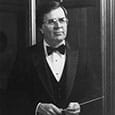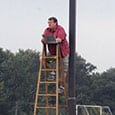A few years ago I was performing the Carnival of the Animals by Camille Saint-Saëns. While the conductor was experienced, he had enjoyed a bit too much brandy (to warm the hands) before the concert. Things were going alone pretty well until we reached the 10th movement, the famous Volière (Aviary). While there is no metronome marking in the score, most conductors choose a tempo between q = 80-90. Tonight was to be different as he set off at a pace clocking in at 120-126. The solo, which features very fast double tonguing to imitate a bird, begins with a two bar introduction with the strings playing tremolo and the bass playing on the first beat and the upbeat of the third beat.
Volière from Carnival of the Animals
.jpg)
As the movement began, and I saw his conducting gestures, my flute life passed before my eyes. There was no way that I could double tongue eight notes to the quarter at 120. Well, maybe for a while but not continuously throughout the 75-second movement. As the first measure was concluding, I looked over at the principal cellist who mouthed “good luck.” I had to make a decision about what to do because if things continued as they were, I would certainly crash and burn.
In those few seconds, I remembered a performance of Tchaikovsky Variations on a Rococo Theme for cello and orchestra, Op. 33 that I had heard when I was a freshman at Eastman. I don’t recall the conductor, but Joseph Mariano was playing principal flute with the Rochester Philharmonic.
Variation IV features the cello in a chattering passage featuring a bouncing spiccato bow stroke. At first the cello asks and answers questions, but as the movement evolves, the flute and cello have a rapid exchange of very quick 32nd notes. The cellist became more and more excited, and the more excited he became, the more he accelerated the tempo. I saw a look of horror and disbelief cross Mariano’s face and wondered what he was going to do. By now it was going faster than anyone could ever double tongue on a flute. I held my breath as Mariano entered. To my astonishment, the first passage at bar 10 came out sparkling clean. The the next passages were equally clear. I soon realized that he was flutter-tonguing the passage. The speed of his flutter-tonguing (done in his throat) perfectly matched this excited tempo. After the concert, Mariano’s colleagues complimented him on his ingenuity. I immediately went to the practice room to work on my flutter-tonguing.
Variations on a Rococo Theme
.jpg)
Back to my Volière. By the beginning of the second measure, I thought about flutter-tonguing the passage as Mariano had done. I decided against this solution as my flutter-tonguing (done with the tongue) was never as clean and clear as Mariano’s. I quickly scanned the orchestration in my head and recalled that for the first six measures of the movement, the strings play the same F major chord tremolo. I knew what I was going to do.
Since there was no harmonic change in the accompaniment, I decided that when I came in at measure three I would set the tempo back to 90 by indicating the tempo with the end of my flute while looking intently at the conductor and hoping he would realize his mistake and follow me. Fortunately it worked, and the movement was saved. Later he apologized for his error.
Mistakes happen. When you are a student, you think professional musicians play perfectly. They try to, but don’t always succeed. At the beginning of a masterclass, former principal horn of the Chicago Symphony Dale Clevenger extended his arm to a young horn student and said, “Touch me. I am human and I make mistakes.” The student looked back in disbelief, but I do think it put him at ease.
Arnold Jacobs, former tuba player with the Chicago Symphony, often mentioned the problems brass players develop when trying to play perfectly. Players who strive never to play a wrong note or chip an attack often overly squeeze the embouchure rather than using the support of the air stream. These players often develop pain when they play or are unable to play at all. Jacobs’ advice was to play musically on the air and realize that sometimes you may make an error.
So what is the take away from these anecdotes? First come to rehearsals and concerts well-rested, prepared, focused, and sober. Work with the metronome so you always know the proper tempo. Georg Solti used a pocket metronome to check tempos just before he went on stage. I use one when playing chamber music where the flute gives the initial tempo for the movement.
Study the full score so you are familiar with the orchestration and what the other parts are playing. Write cues in the music to check where you are and know other parts’ entrances. You may be able help someone get back on who gets lost.
Practice passages faster and slower than marked so you never have any surprises. And for flutists, develop your flutter-tonguing (both kinds) as you never know when you might need it!






